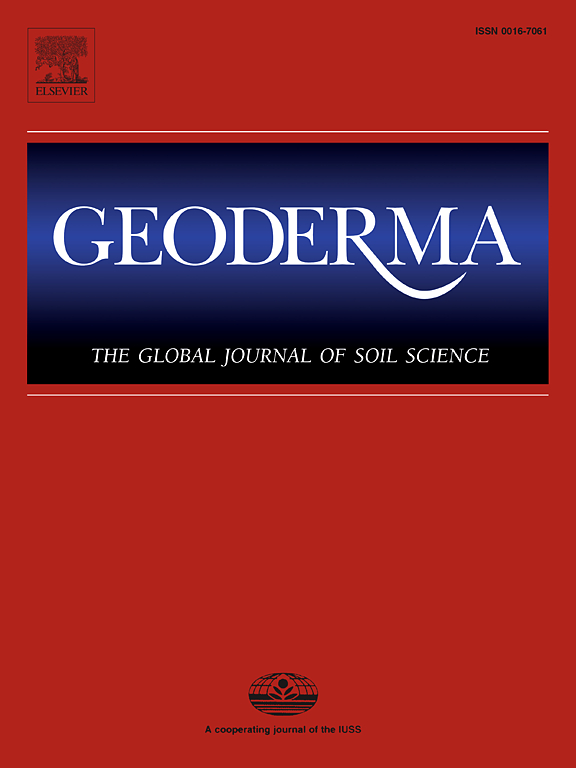Do management practices which enhance nature-based processes improve soil health in olive groves?
IF 5.6
1区 农林科学
Q1 SOIL SCIENCE
引用次数: 0
Abstract
Olive orchards in marginal Mediterranean regions are often cultivated on shallow soils over sloping terrain, with extensive bare ground between tree canopies, leading to severe soil degradation. Implementing management practices that enhance nature-based processes (NBS) is crucial for reversing this trend. Developing simple yet sensitive indicators to assess the impact of these practices on soil quality is essential for evaluating progress toward sustainability goals. In this study, 31 soil health indicators were assessed across 12 olive groves implementing NBS, 12 conventional groves without NBS, and two forest ecosystems. An agroecological sustainability index (ASI) was used to score management practices. Compared to conventional groves, NBS-managed soils exhibited 52–285 % higher levels of soil organic carbon, total nitrogen, and microbiological activity, all of which were significantly correlated with ASI scores. Soil functional α-diversity was also significantly higher in NBS groves and comparable to or exceeding that of forest soils. A minimum data set of eight indicators was identified to establish a soil health index, with effectively detected variations in NBS implementation intensity, showing a significant correlation with ASI (r = 0.76). Overall, NBS adoption led to a 72 % recovery of soil health in olive groves. Given that the ASI relies on qualitative, easily accessible information for farmers and strongly correlates with the soil health index, it could serve as a practical tool for predicting NBS impacts and supporting the European Uniońs sustainability objectives.

加强以自然为基础的过程的管理实践是否能改善橄榄园的土壤健康?
地中海边缘地区的橄榄园通常种植在斜坡上的浅层土壤上,树冠之间有广泛的光秃秃的土地,导致严重的土壤退化。实施加强基于自然的过程(NBS)的管理实践对于扭转这一趋势至关重要。制定简单而敏感的指标来评估这些做法对土壤质量的影响,对于评估实现可持续发展目标的进展至关重要。本研究对12个实施NBS的橄榄园、12个未实施NBS的常规橄榄园和2个森林生态系统的31项土壤健康指标进行了评估。采用农业生态可持续性指数(ASI)对管理实践进行评分。与传统林地相比,nbs管理的土壤显示出52 - 285%的土壤有机碳、全氮和微生物活性水平,所有这些都与ASI得分显著相关。灌木林土壤功能α-多样性也显著高于森林土壤,与森林土壤相当或超过森林土壤。确定了8个指标的最小数据集来建立土壤健康指数,有效地检测到NBS实施强度的变化,显示出与ASI的显著相关性(r = 0.76)。总体而言,采用NBS使橄榄园的土壤健康恢复了72%。鉴于ASI依赖于定性的、易于获取的农民信息,并且与土壤健康指数密切相关,因此它可以作为预测国家统计局影响和支持欧洲Uniońs可持续发展目标的实用工具。
本文章由计算机程序翻译,如有差异,请以英文原文为准。
求助全文
约1分钟内获得全文
求助全文
来源期刊

Geoderma
农林科学-土壤科学
CiteScore
11.80
自引率
6.60%
发文量
597
审稿时长
58 days
期刊介绍:
Geoderma - the global journal of soil science - welcomes authors, readers and soil research from all parts of the world, encourages worldwide soil studies, and embraces all aspects of soil science and its associated pedagogy. The journal particularly welcomes interdisciplinary work focusing on dynamic soil processes and functions across space and time.
 求助内容:
求助内容: 应助结果提醒方式:
应助结果提醒方式:


